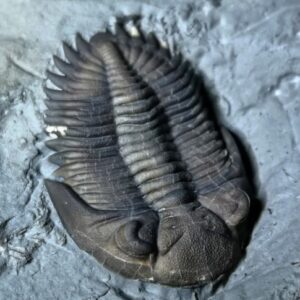Trilobite fossils come from species of creatures that lived in the ocean but died out at the end of the Permian, over 250 million years ago. If you’re like me then you’re wondering what could kill off a species living beneath the ocean water. Well, scientists believe the Permian mass extinction is the cause of more than 90% of all species living on Earth at the time.
Here’s a little background on these animals that longer wander the oceans. Most of them burrowed in sediment, while others crawled across the ocean floor or swam through the open waters. When looking at photos you’ll notice different species which makes collecting them even more fun.
I never dug for and collected fossils while I was traveling the lower 48 states but I find them very interesting and Trilobites are really cool to look at. If you want to dig for your own Trilobite fossils then you’re in luck because you can find them on almost every continent.
Trilobite Fossil Identification
There are several classes of Trilobites, but they all have the same basic design, which includes a left pleural lobe, a middle axial lobe, and a right pleural lobe. They are divided into a Head (Cephalon), Middle (Thorax), and Tail (Pygydium).
Because there are a lot of fakers out there, we’re going to talk about identifying the fakes to determine whether a specimen is real or not.
Air Bubbles
If your Trilobite specimen has air bubbles, it’s a sign that it’s made of resin. The presence of tiny holes no bigger than a half-millimeter in diameter in the matrix or exoskeleton is a sign that it’s fake. Curing casting resin creates this visual formation of bubbles that make tiny holes when they burst. A real Trilobite fossil should not have any visible holes present.

Matrix Colors
The difference in a matrix’s color indicates a fake cast, and those two different specimens have been fixed together. Look closely at the matrix for fine lines separating two colors. A true Trilobite should have more of a consistent coloration within the matrix. You can often find preparation marks designed to try and hide small holes that cast together a Trilobite with an adjacent matrix, trying to produce an authentic look.
Cracks
Many Trilobites are often found in compressed shale layers and are exposed by splitting the matrix. However, many Devonian Trilobites are usually three-dimensional and found in hard limestone. You will notice fine crack lines throughout these specimens which are caused during the process of exposing the sample. Trilobite fossils in a limestone matrix without the presence of residual cracks throughout the specimen and matrix are typically fakes.
Characteristics of Exoskeleton
The exoskeleton of Devonian Trilobites is generally black. However, shades of brown with hints of green are also common. If you find specimens in different colors or are unnaturally shiny, the chances are that the specimen is fake. The authenticity is checked by biting the specimen and putting slight pressure on the front teeth. Fake fossils tend to feel soft, similar to plastic. This is a safe test because biting does not damage authentic Trilobite fossils.

Trilobite Fossil Worth
A Trilobite fossil’s worth can significantly vary depending on several factors, including the species’ rarity, the specimen’s quality, and its size. Some Trilobite specimens have sold for thousands of dollars, while others are more affordable.
Trilobite Fossil Age
This group of extinct marine arthropods existed for over 100 million years before the dinosaurs. They first appeared about 521 million years ago, making them incredibly ancient.
Are Trilobite Fossils Rare?
While Trilobite fossils can be found worldwide, finding a complete specimen is relatively rare. Partial finds are more likely to be found, easier to obtain, and cheaper than complete specimens.

Where Have Trilobites Been Found?
Trilobite fossils have been found on every continent on the planet where Paleozoic outcroppings exist. If you’re looking for a location to dig and collect then Texas and Idaho are the places to visit.
How Are Trilobites Formed?
Similar to any fossil, the first step in the formation includes the death of the plant or animal in water or close enough to fall in shortly after its death. The water insulates and protects the remains from the many elements that play a role in the decomposition process.
Over time, sediments bury the exoskeleton. The faster this occurs, the more likely fossilization will happen. Land and mudslides are a huge help.
The sediments themselves greatly influence how well a Trilobite fossil turns out. Incredibly fine-grained particles, like clay, allow more detail to show through in the specimen. Course sediment, like sand, allows less detail to show. The chemical makeup of the sediments involved plays a role in the coloration of the matrix. While iron produces a reddish color, phosphates can darken the rocks to gray or black.
As sediments continue to pile onto the Trilobite, the lower layers naturally become compacted by the weight of the layers above. Over time, the pressure turns the sediments into a rock or matrix.
When mineral-rich water percolates through the sediment, the Trilobite fossil’s formation process has a better chance of preserving the specimen. Some minerals stick to sediment particles, which glue them together into one solid mass. The minerals have an impact on the original Trilobite. Over the course of millions of years, they dissolve the outer shell and sometimes replace the exoskeleton’s molecules with calcite or other minerals. Over time, the entire shell is replaced, leaving rocks in the exact shape of the Trilobite.
- Identify Enstatite - March 12, 2024
- Identify Cerussite - March 3, 2024
- Identify Bytownite - February 18, 2024
